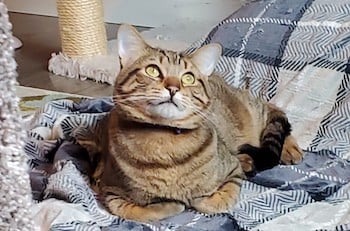
“Cleared for adoption.” Three of the sweetest words a foster cat guardian can hear — second only to “Adopted!” This means your foster cat is officially ready to find their forever family. You’re in the home stretch. So, what can you do to help your foster cross the finish line?
In this article, we’ll talk about the foster guardian’s role in the adoption process, how to work with the rescue organization to promote your foster cat, sharing the news with your network of family and friends, and catching the perfect “adopt me” kitty pose for the camera.
Be sure to check out our other Foster Cats 101 articles:
- Foster Cats 101: Why You Should Consider Fostering a Cat
- Foster Cats 101: How to Become a Foster Cat Guardian
- Foster Cats 101: Applying to be a Foster Volunteer and Finding a Foster Cat
- Foster Cats 101: Your First Foster — Set Up and What to Expect
- Foster Cats 101: Caring for Your Foster Cat
- Foster Cats 101: Saying Goodbye to Your Foster Cat
Helping the Rescue Organization Prepare for Your Foster Cat’s Adoption
Your foster cat is your primary focus. But it’s important to remember, the rescue organization has many, many animals in their care and at various stages of intake, recovery, and adoption. You’re going to want the search to begin for potential adopters the second they’re cleared to be adopted. It may take a little time though. Your foster cat has a safe, happy home with you, whereas other cats in the rescue facility really need to get into permanent homes and may take priority. So be patient. But don’t be afraid to send a reminder here and there and check on the status of things. Advocate for your foster cat while remembering the rescue staff has a LOT on their plates.
 Share What You Know About Your Foster Cat
Share What You Know About Your Foster Cat
The rescue organization should rely on you to provide insights, based on your time with your foster cat, to help them find the right home. They’ll often have a questionnaire for you to fill out or ask you to write something they can post on their website. They may even ask you directly what kind of family scenario you’d suggest. After all, you know your foster cat better than anyone at this point. And you have a wonderful opportunity to act as their advocate and help them find exactly what they need in a family.
Here are some examples of information the rescue organization may find helpful as they prepare to put your foster cat up for adoption. I like to make sure I hit these six areas:
- Personality: Is your foster cat fun, active, mellow, energetic, needy for affection, aloof, etc.?
- Behavior: Does your foster cat pick up on new training easily? Bite when touched in specific places? Can their play get a little aggressive at times? Do they respond well to positive reinforcement using treats, know “come” and “sit” clicker training commands? Do they get scared by loud noises, etc.?
- Play: Does your foster cat love to chase spring toys or other types of toys? Do they get the zoomies every evening? Are they just learning to fetch? Are they not interested in toys, etc.?
- Affection: Are they a big cuddle bug, or perhaps not super affectionate now, but likely will be over time? Does your foster cat like petting on the head and chin scratches or respond negatively to belly rubs? Do they prefer to sleep with you and/or other pets at night, etc.?
- Interactions: Does your foster cat get along well with other cats, play with those who want to engage and leave the others alone? Have they been exposed to dogs, or met a child and did well with the interaction? Are they nervous around new people, take an hour or so to get comfortable, etc.?
- Be aware: Did it take a few days to stop hissing after arriving in foster care, or may act more aggressive initially in a new home but calmed down with a little time? Do they need training on counter surfing and midnight play sessions? Should adopters consider a water fountain to encourage drinking? It's important to share these behavior and training tips with an adopting family.
- The basics: And of course, the rescue organization will ask about the basics. How well does your foster cat eat? Do they use the litter box appropriately? Any issues with drinking enough water?
Here’s the evaluation form one rescue organization uses for check-ins and pre-adoption prep. I sometimes provide an additional page with more detailed information if I think it’s necessary – particularly for cats going through socialization training or medical recovery that may continue with the adopting family.
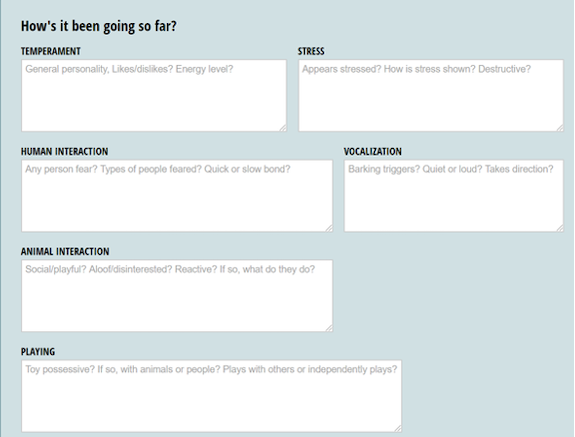

Don’t Leave Out the Details
You may have noticed that not all of my examples above were warm-and-fuzzy. Your impulse might be to talk up all the wonderful things and try to sweep any potential issues or challenges under the rug. But don’t. What happens if you “forget” to mention that your foster cat sometimes bites when picked up, and the adoption team selects a family with a young child who’s expecting to carry kitty to bed every night? That’s a recipe for disaster, potential injury, and maybe a return to the rescue. Whereas a single adult or couple, who have a little patience and are willing to continue working with the cat on this issue, would be a great fit. Your adoption team needs to know it all — good, bad, and indifferent — so your foster cat has the best chance for successful adoption.
Get Out Your Camera!
The rescue organization will also need photos and videos to showcase your foster cat on its website, social channels, and any other places they promote their animals available for adoption. And you’ll hopefully be doing a little promoting of your own.
Tips for Taking Great Photos and Video of Your Foster Cat
If you’re anything like me, you’ll be shooting and filming EVERYTHING and thinking your foster is the smartest, cutest, most amazing cat in the world. But in reality, the rescue is only going to use a few photos and videos. So, you really want to try and get some quality shots.
- Keep your camera handy. You want to catch those special, intimate, amazing moments that make you say “awwwwww.” Of course, if your cats are anything like mine, they’ll stop doing whatever you want to capture, the second you turn the camera on.
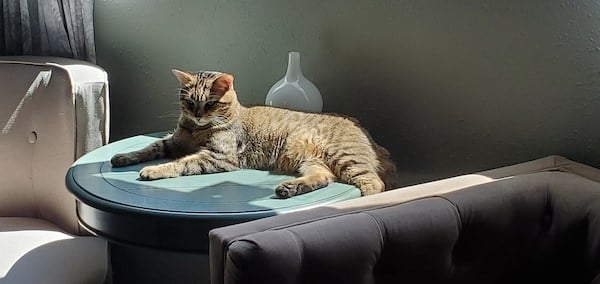
- Consider photos showing interactions with people and other animals. A great photo of a cuddly or playful moment can help paint a picture for potential adopters and show your foster cat gets along well with others. (But make sure you have pics of just your foster cat, as well. This isn’t the selfie show. You’re showcasing the cat, not you with the cat.)
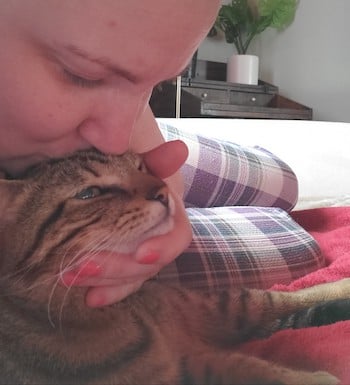
- Eye contact, even through a photo, can help create a connection. Be sure to get some shots with your foster cat looking straight into the lens. You can try and grab their attention with a toy. But be prepared for a pounce. Sometimes just saying their name, snapping, or waving an arm is enough to get a cat to look your direction without abandoning their cute pose.
- You know all the wonderful aspects of your foster cat’s personality — try and get it in a pic or on video. That silly head tilt or ferocious growl that comes out when they’re chasing a toy mouse. The things you love are likely the same things that will help a potential adopter fall in love.
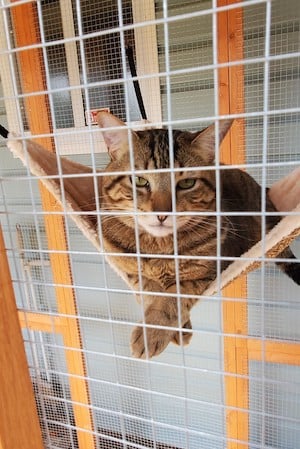
- Try to keep videos short and full of interesting content, to hold the viewer’s attention. 60 seconds of you talking to the cat while he’s running off into the other room isn’t going to keep potential adopters engaged. Aim for short clips, or if you have video editing software, edit clips together to tell a compelling story or show progress your foster cat has made.
- Moving the camera too much can be disorienting. If you’re trying to catch an action shot, try framing the shot and letting the cat move in and out of the frame.
- Turn on the lights! Lighting is often forgotten when we whip out our camera phones, but it's crucial for viewers. Make sure that your photo or video is well-lit. Natural daylight is always a good choice, so open up as many curtains or blinds as your can. Turn on overhead lights and any lamps nearby so viewers can clearly see your foster kitty.
- Check your orientation. You might want to check with the rescue organization to see if they need a specific camera orientation (horizontal, landscape, square) for their website and social platforms. They may also have file size and length limits for video. But it’s likely they’ll have someone on staff who can edit if that’s not in your wheelhouse.
Things You Can Do to Promote Your Foster Cat
The rescue organization will be doing their fair share of promotion. But you can help spread the word to increase the chances of a quick adoption. Social posts, the message boards at work, your church group, or book club, you name it. You probably have a more extensive network than you realize.
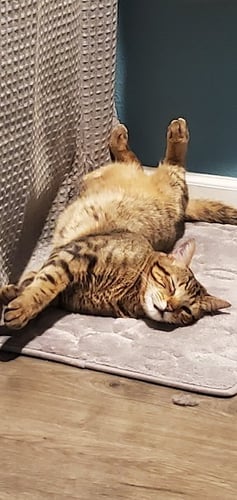 Spread the Word
Spread the Word
This is a really cool part of fostering a cat. You have a legitimate excuse to exhaustively post photos and videos of your foster on social media. In fact, when I got my first foster, I immediately posted to my social media account, “If you don’t want to see an unending stream of foster cat stories and videos, feel free to unfriend me — no hard feelings — because my first foster is here and I’m about to go post-crazy!”
In all posts, make sure you include the name of the rescue organization. They generally handle the screening of potential adopters and the final selection. Any interested parties will need to reach out to them directly. But some rescues will give special attention to friends and family of the foster guardians.
Okay, yes, there’s more to helping your foster cat get adopted than filming funny videos. But they help!
How to Write About Your Foster Cat
I did say you need to make a note of any possible issues or challenges with your foster cat. Potential adopters should be aware. However, don’t feel like it’s your responsibility to cover everything an adopter might need to know in your promotion. You’re sparking people’s interest. The rescue organization will handle the details. When you’re writing about your foster, whether it’s for a social media story or a blurb to go on the rescue’s website, I suggest keeping it positive, light, and full of heart.
Here are some examples of what I might say about my current foster cat:
"When you look into this little boy’s eyes, you can see straight through to his heart. Ollie is the master of the adorable, inquisitive head tilt. And if you’re looking for playful, he’s your guy. His zoomies are something to see – flying through the house and growling like the house tiger he is. He also gets along wonderfully with other cats and loves to play all day and cuddle up with them at night."
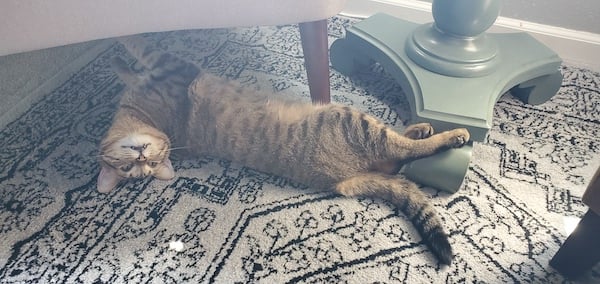
"Ollie’s a subtle guy. He doesn’t necessarily want all the focus on him. But he loves a good chin scratch or nap in your lap. He’ll quietly follow you from room to room and give you the sweetest looks to show he cares. Not to mention he has one of the best all-time cat noses. Ollie needs an adult family with a little bit of patience as he learns how to communicate with his humans. He learns so quickly! I have no doubt he will continue to grow into an even more loving, well-behaved, perfect family member."
Make Notes for the Adopting Family
As I get to know my foster cats, I’m always making mental notes of things I think their adopting families should know, either through telling the adoption team, meeting the adopter face-to-face, or in a letter the rescue passes along. Quirks, likes and dislikes, favorite treats, training notes, etc.
You can also think about things that will help the transition. For my current foster, I want them to know how he reacted when I first brought him home and the steps I took to help him settle in. A great tip from certified feline behavior and training consultant Marci Koski — who I now call my cat’s therapist — is to share the training techniques I used to address his aggression issues. He may experience some of those same stresses and reactions as he gets familiar with his new home. If the adopting family uses the same approach I used, he’s likely to feel more at ease and respond more quickly because of the familiarity with those techniques.
You can also send along a favorite blanket, toys, and other things to make them feel at home, just like the rescue organization did when you took them in.

In Closing
That’s it! Success! You’ve just changed the life of an amazing cat, and a deserving family, forever. Feels good, right? I’m betting you can’t wait to do it again. Take a little break from fostering if you need one. If you didn’t feel like the organization you worked with was the right fit, you can look for others. There are many different groups, large and small, with and without their own facilities, who desperately need foster families. Maybe even tell your friends and try to recruit a new family to the foster fold. And, when you’re ready, jump back in and do it all over again … and again … and again … and again ...
Related Articles
- Foster Cats 101: Why You Should Consider Fostering a Cat
- Foster Cats 101: How to Become a Foster Cat Guardian
- Foster Cats 101: Applying to be a Foster Volunteer and Finding a Foster Cat
- Foster Cats 101: Your First Foster — Set Up and What to Expect
- Foster Cats 101: Caring for Your Foster Cat
- Foster Cats 101: Saying Goodbye to Your Foster Cat




